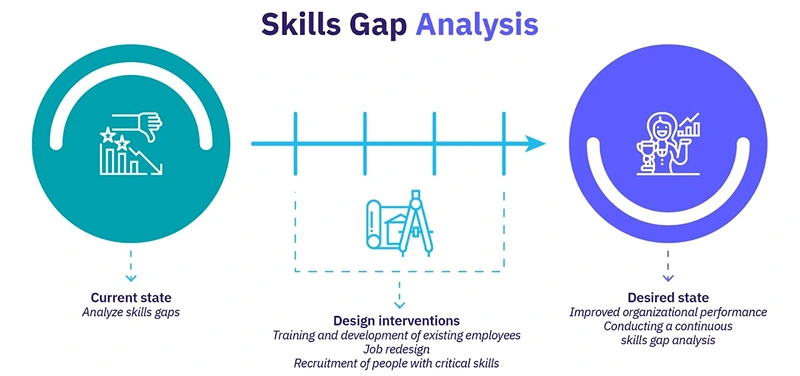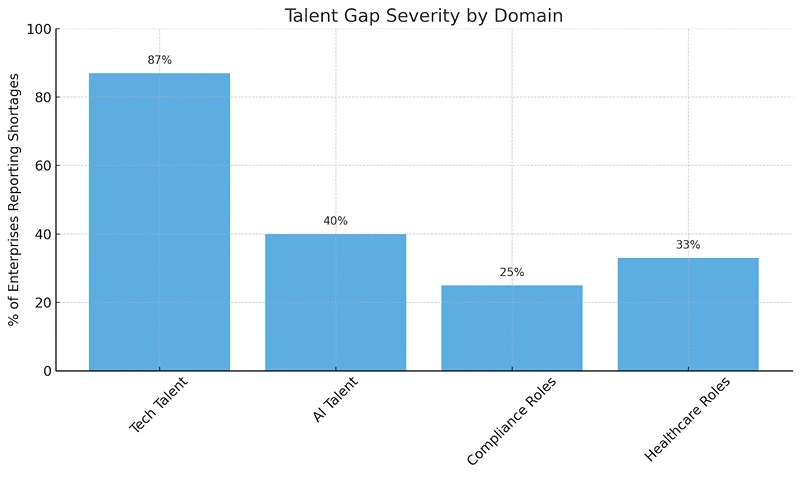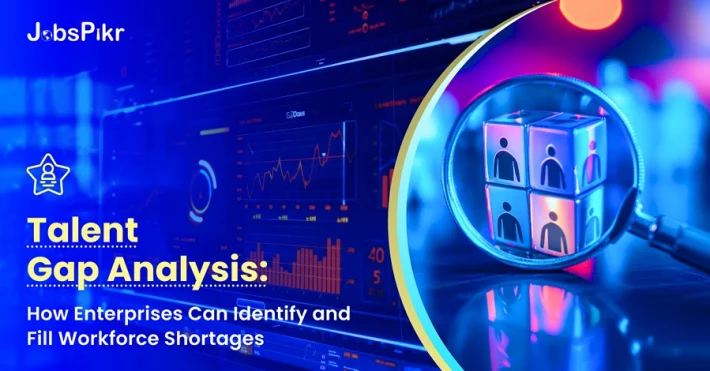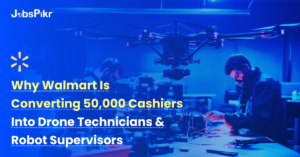In an increasingly complex and digitally driven economy, enterprises are facing growing challenges in identifying and addressing workforce shortages. The misalignment between available skills and business requirements has led to the widening of what experts call the talent gap. For organizations aiming to remain competitive, talent gap analysis becomes essential. This strategic process helps businesses evaluate their current workforce, anticipate future skills requirements, and align hiring and reskilling efforts accordingly.
According to the World Economic Forum, more than 50% of all employees will require significant reskilling by 2025 to meet evolving job demands (Source). This signals a pressing need for companies to implement data-driven talent gap analysis to proactively address these deficiencies before they impact productivity, innovation, and revenue.

In this article, we’ll explore the fundamental components of a talent gap analysis, how organizations can use workforce data to guide hiring and reskilling strategies, and proven best practices to address the tech talent gap, AI talent gap, and broader workforce needs.
What Is Talent Gap Analysis and Why It Matters
Talent gap analysis is a strategic evaluation that measures the difference between the skills a company currently possesses and the skills it needs to meet its business goals. Unlike traditional performance evaluations, talent gap analysis focuses on future-readiness.
Why It Matters:
- Identifies critical skill shortages across departments and geographies
- Supports strategic workforce planning
- Informs reskilling and upskilling programs
- Enhances recruitment strategies and workforce allocation
- Enables budget optimization and succession planning
Talent gap analysis is especially vital for industries facing rapid transformation, such as technology, healthcare, manufacturing, and financial services, where digital transformation is increasing the demand for specialized and emerging skills.

The Rise of the Tech and AI Talent Gap
The growing reliance on digital technologies and AI has created a severe talent bottleneck in critical areas such as cybersecurity, data science, machine learning, and software development.
Industry Statistics:
- A survey found that 87% of companies are either currently facing or expect to face a tech talent gap in the next few years.
- According to IBM, the demand for AI talent gap is expected to grow by 40% annually, with demand far outpacing supply.
The implications of these gaps are not just limited to project delays; they affect innovation capacity, competitiveness, and business scalability.

What Are The Key Components of a Talent Gap Analysis
A comprehensive talent gap analysis typically includes the following steps:
1. Skill Inventory Mapping
Create a complete inventory of current employee skills, certifications, and experience. Use skills matrices and self-assessments combined with performance data.
2. Future Workforce Needs Assessment
Define future job roles and skills aligned with your business strategy, growth plans, and digital transformation initiatives.
3. Gap Identification
Compare current workforce capabilities against future needs. Highlight high-risk gaps where critical roles are under-supported.
4. Role Prioritization
Not all gaps are equal. Focus on roles tied to business growth, compliance, innovation, and revenue generation.
5. Data-Driven Forecasting
Leverage predictive workforce analytics to project turnover, retirement, and skills obsolescence, helping organizations plan ahead.
6. Strategic Talent Initiatives
Design learning & development (L&D), internal mobility, and external hiring strategies to close the gap.
Using Workforce Data for Targeted Talent Planning
Enterprises must transition from reactive to proactive hiring by embedding workforce intelligence into planning processes.
How to Use Data:
- Track internal mobility trends to identify ready-now talent
- Monitor external job market signals to benchmark against competitors
- Use HRIS and ATS systems integrated with AI to scan for skill clusters
- Analyze churn data and exit interviews to find systemic skill weaknesses
Workforce data also helps HR leaders assess whether to build, buy, or borrow talent, depending on the urgency and cost of closing a gap.
Best Practices for Conducting Talent Gap Analysis at Scale
As enterprises grow across multiple business units and geographies, conducting a comprehensive talent gap analysis becomes increasingly complex. To address this challenge, organizations must adopt scalable frameworks and modern technologies that enable holistic workforce assessments. Below are some of the best practices to successfully perform talent gap analysis at an enterprise level.
1. Centralize Workforce Data Across Functions
Integrating HR data with insights from operations, L&D, finance, and business strategy departments is key to understanding where real skill deficiencies lie. A centralized data infrastructure helps organizations move beyond departmental silos and ensures decision-makers have access to complete talent insights. For example, combining attrition data with performance analytics and future demand modeling can uncover hidden gaps and bottlenecks.
2. Use Scenario Planning to Prepare for Future Skills Needs
Scenario planning allows companies to test talent strategies under multiple business contexts such as mergers, market expansions, automation investments, or regulatory changes. By modeling different future states, organizations can evaluate the resilience of their workforce strategy and prepare proactive interventions. This technique also supports contingency planning by mapping alternative skills or talent pipelines.
3. Create Enterprise-Wide Skills Taxonomies
A well-defined and standardized skills taxonomy is foundational for conducting accurate and repeatable gap analyses. Enterprises should classify job roles and competencies across departments using a common language. This consistency makes it easier to analyze workforce data, track progress on closing gaps, and ensure alignment between talent supply and business demand.
4. Leverage External Benchmarks and Labor Market Data
Relying solely on internal HR data limits the scope of gap analysis. Businesses must benchmark against market standards to understand whether their workforce capabilities align with industry best practices. Tools like JobsPikr provide real-time labor market data that compares your talent demand and supply with peers in your sector and geography—enabling smarter hiring, compensation, and skills development decisions.
5. Establish Continuous Measurement and Feedback Loops
Talent gaps are dynamic. Enterprises should establish ongoing measurement systems to track the effectiveness of their talent interventions. Metrics such as time-to-fill for key roles, upskilling program participation, internal mobility rates, and workforce readiness scores help monitor progress. Integrating feedback from managers and employees also ensures gap analysis remains grounded in real business needs.
By implementing these best practices, enterprises can transform talent gap analysis from a one-time HR initiative into a continuous strategic function that evolves with business priorities and workforce dynamics.
How to Address Talent Gaps Through Hiring and Development
Addressing workforce gaps effectively requires a dual-pronged approach that involves both external hiring and internal development. Organizations must assess which roles demand urgent external recruitment and which can be fulfilled through upskilling existing employees. AI-powered hiring platforms, internal mobility programs, and learning academies all contribute to reducing the gap efficiently.
External Hiring:
- Prioritize roles with long time-to-productivity timelines for external sourcing
- Create employer branding campaigns that attract in-demand talent
- Use AI-based sourcing tools for better candidate-role fit
Upskilling and Reskilling:
- Launch internal academies or partnerships with EdTech providers
- Incentivize career development through recognition, rewards, and promotions
- Focus on high-impact areas like cloud computing, DevOps, data science, and AI
Internal Mobility:
- Build transparent internal job marketplaces
- Match employees to roles through AI skill-matching algorithms
Talent Gap Analysis in Action
To understand how leading enterprises put talent gap analysis into practice, it’s essential to explore real-world case studies. From multinational tech companies launching internal certification programs to healthcare systems expanding academic partnerships, data-driven approaches are proving critical in closing talent shortages and building resilient teams.
Case Study 1: Multinational Tech Enterprise
- Identified a shortage of cloud architects and AI engineers
- Implemented an internal cloud certification program
- Reduced external hiring by 35% and boosted retention of tech talent
Case Study 2: Financial Services Firm
- Used predictive analytics to identify future retirement risks in compliance roles
- Launched a mentoring and training initiative
- Achieved 90% succession coverage for critical positions within 18 months
Case Study 3: Healthcare System
- Faced acute shortages of data-savvy clinical professionals
- Partnered with universities for targeted internship programs
- Increased hiring pipeline by 50% in under a year
How JobsPikr Supports Enterprise Talent Gap Analysis
JobsPikr’s workforce intelligence platform provides:
- Real-time labor market data on job trends, skills demand, and salary benchmarks
- Talent supply mapping across geographies and industries
- Predictive analytics to project skill shortages and hiring risks
- Custom dashboards for CHROs and workforce planning teams
By integrating JobsPikr, enterprises gain the ability to proactively address talent shortages, enhance hiring strategies, and make smarter workforce planning decisions.
Turn Workforce Challenges into Opportunities with Data-Backed Insight
As workforce dynamics continue to evolve, enterprises must adopt a proactive and data-driven approach to identifying and closing talent gaps. Through comprehensive talent gap analysis, businesses can align their workforce capabilities with future demands, mitigate hiring risks, and enable long-term growth.
From mapping skills to launching upskilling programs and leveraging labor market data, every component of the talent gap strategy must be integrated into enterprise-level decision-making.
Sign up with JobsPikr today to transform your talent strategy using real-time labor market insights and predictive workforce analytics.



